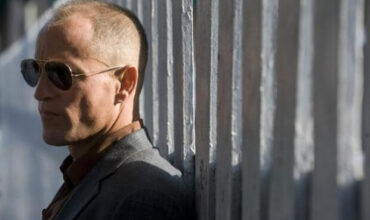In Sam Mendes’ new film 1917, it is early in the title-year. What we now call World War 1 has been unfolding since the latter half of 1914. The Western Front is the main theatre of war and stretches from the North Sea, through France and Belgium to the Swiss Border. The Allied Powers, France, United Kingdom and Belgium conflict with the German Empire and Austria-Hungary. Millions of casualties have been sustained on both sides. There is mile upon mile of trenches. Neither side has captured significant territory for years. But now, there is intelligence that the German forces are retreating. Some in Allied Command see this as an opportunity to break through German lines. They believe this might be the path to victory.
In Northern France, two young Lance-Corporals, Tom Blake (Dean-Charles Chapman) and William Schofield (George MacKay), are given a less optimistic message to deliver to the 2nd Battalion of the Devonshire Regiment; they are to call off their forthcoming attack on the Germans, because an ambush has been planned by the enemy, which would decimate the 1,600 men of the Battalion. One of those soldiers is Blake’s older brother, which gives the younger man extra incentive for his mission. Blake and Schofield need to cross no-man’s land and make their way to the original German line, which is now supposedly abandoned. From there, they must locate the 2nd Battalion before they launch the attack, next morning.
Mendes makes the decision to concentrate almost all the action of the story on the physical journey of Blake and Schofield. We follow them through trenches, across barbed-wire, into an underground bunker and numerous other locations in the nightmare landscape that is the Western Front. Destroyed villages, piles of corpses and a multitude of rats show in stark detail the far-reaching damage and slaughter that has been perpetrated. Even Blake and Schofield, who are somewhat inured to these horrors, discover there are still sights that can disturb them. As we follow them, we become emotionally invested in their potentially life-saving mission. As they face obstacle after obstacle and the clock ticks down, we fear they may not reach their goal. There is not even the certainty that their message, which is an order from the very highest level, will be obeyed once received, such is the mayhem and disorder of this war.
Mendes has directed a technically-brilliant war film in collaboration with award-winning cinematographer Roger Deakins. The visuals are bleak and beautiful. The choreography of camera coverage and the movement of performers through complex physical spaces is stunning. There has been chat on-line about the movie being filmed all in “one-shot” which is PR fluff similar to the claims made about BIRDMAN (the 2014 movie directed by Alejandro Iñárritu). Deakins used ARRI’s latest cameras (the Alexa Mini LF) and their TRINITY stabiliser system to capture the extended sequences required to fulfil Mendes’ vision. The result was given to Oscar-winning Lee Smith (INTERSTELLAR) to edit together seamlessly in post-production. The result is so slick, that there are times when it feels as though we’re inside a computer game; a Western Front first-person-shooter.
Because the film imitates real-time elapsing, we are not privy to the deeper thoughts of Blake and Schofield. Their world is minute-by-minute reactions. The screenplay does provide several rest and reset points and in these scenes, we gain some further knowledge of the type of men these soldiers are. The film has moments when those in authority are revealed, albeit briefly and there are cameo appearances from Colin Firth, Benedict Cumberbatch, Andrew Scott and Mark Strong. Dean-Charles Chapman is very good as the impulsive Tom Blake and George MacKay is excellent as the more thoughtful William Schofield. (MacKay also impresses in Justin Kurzel’s recent offering, TRUE HISTORY OF THE KELLY GANG).
I was reminded on more than one occasion of the “British Tommy” sequences in Christopher Nolan’s World War 2 epic, DUNKIRK (2017). Although the action is not covered with precisely the same techniques, the camera-work has a similar, intimate fly-on-the-wall feel. Both films make the same choice to barely reveal the enemy. This is a positive decision in one sense, in that the German forces are not demonised, but nor are they humanised. They are lethal, yet abstract.
Mendes’ screenplay is a fictional tale set during the real-life Operation Alberich which was the strategic German retreat back to the carefully prepared Hindenberg Line. He based some events on anecdotes told to him by his grandfather, Alfred Mendes, who actually fought in The Great War (which was its other name). This tribute to his relative’s stories was augmented by Mendes’ research into other contemporary accounts he found in the Imperial War Museum.
War movies are historical re-enactments that often draw criticism. History may be written by the winners, but eventually the descendants of the victors and the vanquished will recount their own versions. The Great War took place 100 years ago. All the participants are gone, so a retelling of these events does not have living-memory behind it. Those who are alive now, reshape the stories according to research, and hopefully they can form a clearer understanding of the chaos and madness of that era. 1917 is a well-crafted recounting of what life might haver been like for British soldiers on the Western Front. It is the very best film that Mendes has made in his twenty-year film career.
Running time is 1 hour and 59 minutes. (8/10)


